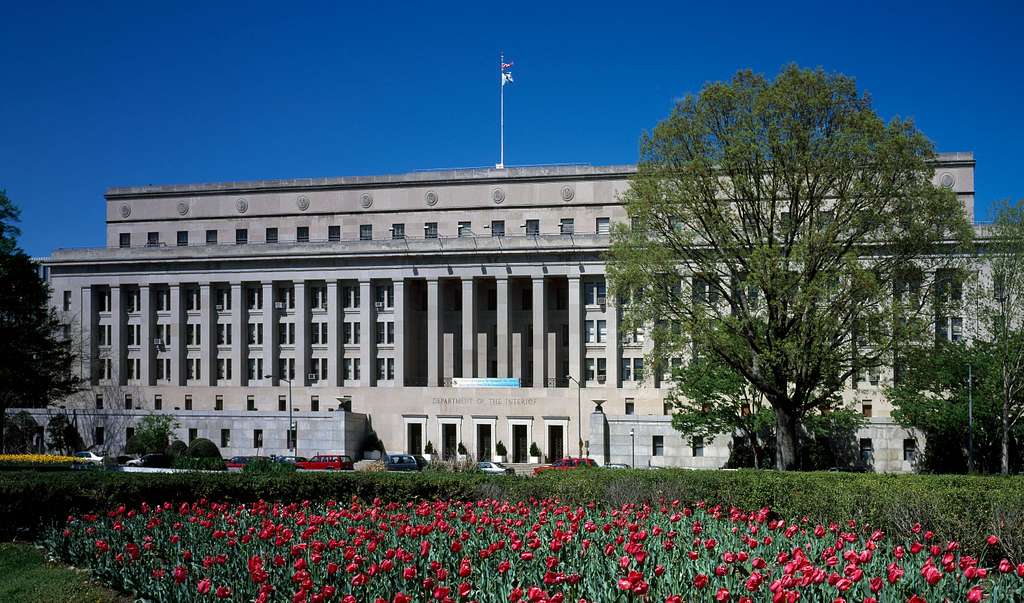On March 17th 2025, Government Executive reported that the Department of Interior sent buyout offers to its entire staff. Internal White House documents obtained by the Washington Post additionally suggest the department may cut nearly 1 in 4 of its employees. Doug Burgum, Trump’s Secretary of Interior, and Scott Turner, Secretary of Housing and Urban Development, have also published a plan to use federal land managed by the Department of Interior for new housing developments. The two heads promised they will reduce “red tape” for these developments, such as “lengthy environmental reviews, complex transfer protocols and disjointed agency priorities.”
The Department of Interior has a complex history tied to American expansionism and extractive industries. Today it still manages many relationships between indigenous communities and the state. “It oversees more than 500 million acres of federal lands, and exercises oversight over U.S. domestic energy production on leasing, mining, and drilling rights on them.” The Department seems perfectly able to approve new leases for oil and gas extraction on public lands with its diminished staffing capacity. On the other hand, fighting the harm that extractive industries have wrought upon the climate and communities requires staffing levels DOI has lacked for years.
At the end of Biden’s term, the Department of Interior had not recovered from staffing cuts instituted during the first Trump administration. The 69,397 employees reported in FY 2024 is over a thousand less than the 70,968 who worked there in 2016. Additionally, the staffing levels in 2024 are a far cry short from the 110,000 full-time employees (FTEs) that Mariko Lewis and Mariama Sojourner Eversley argued the department needed in 2021.
Here are the responsibilities the Department of Interior needs more staffing to properly fulfill:
- Preventing Dangerous Pollutants From Harming The Health of Indigenous and Poor Communities: Inactive wells, when not sealed properly, can leak “dangerous levels of benzene (a carcinogen), methane (a greenhouse gas), heavy metals, radioactive substances, hydrogen sulfide and ozone.” Often, these wells and pipelines are near poor and indigenous communities, forcing them to bear the brunt of the negative health effects from these dangerous pollutants. 48 abandoned wells were discovered on Navajo Nation land in 2018, and it has been estimated that there are hundreds more (potentially thousands more) on other pieces of indigenous land.
- In 2021, about one employee at the Bureau of Land Management (BLM) oversaw 23,000 acres of land. One BLM field officer said he visited “less than 15%” of his assigned wells each year. In 2021, Lewis and Sojourner Eversley estimated that the BLM in particular required 17,000 FTEs to start to adequately oversee these wells and pipelines – far short of the 10,925 the bureau reported in September 2024.
- Maintaining Our National Parks: National parks exist to conserve and protect the environment and wildlife. However, these parks have faced staffing shortages amidst huge surges in visitor numbers for years. “Over the past decade, national parks have seen a 20% increase in visitation, but because of insufficient federal funding, NPS has lost 3,500 employees, or 16% of its staff capacity […] The lack of sufficient resources is wreaking havoc on busy parks, which find themselves unable to afford sufficient staff to meet with the onslaught of guests.”
- Hiring Wildland Firefighters: The Department of Interior, through its bureaus, is partially responsible for hiring and maintaining a wildland firefighting force. In a November 2022 report, the Government Accountability Office (GAO) found that recruitment and retention of firefighters has been strained while their importance has increased due to the increased severity and length of wildfire seasons. According to an August 2024 interview with Luke Mayfield, the president of Grassroots Wildland Firefighters, 25 percent of the desired capacity is missing of “roughly 18,000 federal wildland firefighters across the Department of Interior and United States Forest Service […] in the state of California, some of those vacancy rates can exceed 50 plus percent.”
- Protecting Fish, Wildlife, Plants and Their Habitats: The U.S. Fish and Wildlife Service, housed within the Interior, has been in the midst of a staffing crisis for over a decade. The service manages the National Wildlife Refuge System, a network of protected public lands and waters.
According to the Refuge Association, the system
“has lost over 800 permanent positions since fiscal year (FY) 2011, resulting in an enormous 27% loss in capacity […] No national wildlife refuges are fully staffed, and more than half have zero staff on-site, leaving many refuges closed to the public and completely unmanaged. Much of the Refuge System is virtually unprotected due to the lack of law enforcement officers, with some officers covering entire states and refuge units hours away from one another. The staffing shortage also impacts refuge volunteers. Many volunteer programs–critical for the operation and maintenance of refuges–are being cut back or entirely eliminated due to a lack of supervision from full-time professional staff or necessary infrastructure.”
We are analyzing the state of understaffing across the executive branch (a trend kept up by both Democratic and Republican administrations) and assessing what Trump’s cuts would mean for everyday Americans. Read the rest of the posts in our Federal Understaffing Spotlight.

